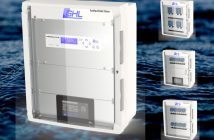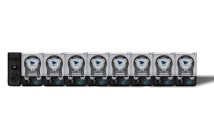This is Part 4 of a Multi-Part Article on aquarium filtration and the basic anatomy of a saltwater aquarium. So be sure to stay tuned for the remainder of the article…
In Anatomy of a Reef Aquarium – Part 1, we discussed setting a budget for your reef aquarium build and determining the type of livestock desired. We followed part one with Anatomy of a Reef Aquarium – Part 2 discussing the shape of the aquarium as well as the material it is made out of. The third installment, Anatomy of a Reef Aquarium – Part 3 is dedicated strictly to aquarium lighting. In part 4 we’ll discuss protein skimmers.
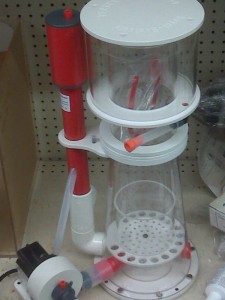
Vertex Alpha 170 Cone Skimmer
Aquarium filtration is another very important aspect of any saltwater aquarium, and especially in reef aquariums. Dissolved organics, harmful chemicals, and a variety of other nutrients can build up in an aquarium and can cause fish health issues, algae growth, and a whole plethora of other things. Water changes are the most ideal and effective form of nutrient and chemical removal, but reefkeepers can’t spend all of their time changing water. Hence, a variety of filtration devices have been developed to expand the time between water changes. Protein skimmers are currently the most popular method of aquarium filtration, and even occurs in nature.
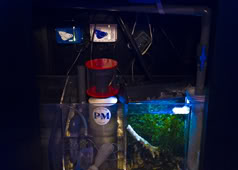
PM Redline Skimmer and EcoTech Vortech Pumps
The protein skimmer is the most common piece of aquarium equipment. Called a foam fractionator, skimmers function by injecting tiny air bubbles into the water inside of a container (often a cylinder or cone), which then rise to the top. As the bubbles rise in the skimmer, they do two things. First, they expand in size because pressure surrounding the bubble decreases the shallower it gets. Second, the rising bubbles capture dissolved organic matter and proteins on their surface. The rising and expanding bubbles reach the top of the skimmer and pop, depositing the organic material into a collection cup. This collection of organic material, called skimmate, is permanently removed from the water. Traditional filters such as canister filters trap detritus, but that trapped organic material remains in the aquarium’s water, making these filters ineffective.
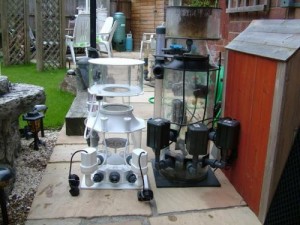
Deltec TC3070 (left) vs Deltec AP1004 (right)
Protein skimmers come in a wide variety and styles. The most commonly used skimmer is the needlewheel and venturi protein skimmer. The venturi draws air into the water while the needlewheel chops the air into tiny bubbles. These skimmers are very popular because they can remain small, but handle large setups. Additionally, the pumps used on these systems draw very little power when compared to other styles of skimmers. Other popular skimmers available to hobbyists are the Beckett skimmer and the downdraft skimmer. They are very similar to each other, both functioning by using very large and powerful pumps to force water over or through a bubble creating apparatus. The downdraft skimmer blasts water at very high pressure onto something like a plastic “bio-ball” or other plastic material to create a massive amount of bubbles. The Beckett skimmer forces water through a special injector that functions similarly to the bio balls of the downdraft skimmer. Regardless of how the bubbles are created, both the downdraft and Beckett skimmers require high energy using pumps to perform their tasks. These protein skimmers do work well, but their needlewheel counterparts can perform the same function and operate more cost and energy efficiently.

Skimmer Collection Cup
In recent years, the shape of the skimmer has changed. Traditional protein skimmers were cylindrically shaped. They consisted of a cylinder made of a plastic material (often PVC or acrylic) that had a pump located near the bottom of the device. The cylinder would become more narrow at the skimmer’s neck, but this narrowing was not drastic. Over the past few years though, a cone shape has been used to create a skimmer. The base of the cone skimmer is very wide, with the body tapering sharply until it reached the neck. This design, along with a few other design changes (e.g. the bubble diffusing plate), was though to drastically reduce the turbulence within the protein skimmer’s body, thereby making bubble formation and protein removal more efficient. Judging from the response of reef keepers around the globe, the cone skimmers do in fact improve a skimmer’s performance by 20% or more. The debate on cone vs cylinder skimmers will have to come to halt for now, as it is better left to its own discussion.
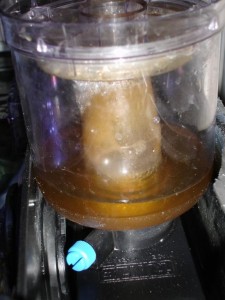
Tunze Nano Skimmer Collection Cup with Skimmate
Wrapping things up, the protein skimmer is, in my honest opinion, the single most important piece of aquarium filtration equipment. Regardless of which style you use or prefer, protein skimmers effectively remove harmful organics and other nutrients from the water and extend the time between water changes.


